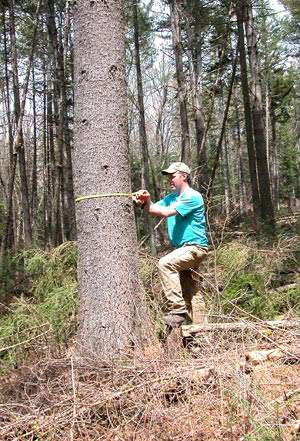DBH is shorthand for the diameter of a tree’s trunk measured at breast height. Setting aside the interesting and potentially delicate new questions the latter two words raise, let’s first consider diameter. My geometry teacher told me it’s a line segment passing through the center of a circle, the maximum distance from one point on the circle to another.
In forestry, it gets more interesting. Because trees are solid and somewhat cylindrical, determining their diameters is not quite as simple as measuring a line across a circle. Still, diameter at breast height is probably the most common and important measurement made on standing trees. This is because it is directly measured, and so many other important tree attributes and values – things like tree growth, wood volume, and basal area – can then be estimated from it. Accordingly, every forester, ecologist, naturalist, and tree nut records the diameter of trees – whether their passion is wood or wilderness. Or just measuring things.
Because people in the natural sciences like to compare notes, they all refer to tree diameter as DBH and they all make the measurement in much the same way. Clearly, if their results are to be comparable, their measurements must be specified and consistent. Given that all trees vary in size and form, it may seem odd that their diameters would be measured in the same way. But it is precisely because trees vary that a standardized approach is followed. For one thing, trees stems are not perfect cylinders; they taper. If I measure a tree’s diameter at knee height and you measure it at eye level, I’ll probably record a bigger number for that tree than you will. This is not good.
Instead, to deal with the vagaries of tree form and terrain, foresters – by convention – all measure diameter according to a set of standard methods. And yes, even the wide range of breast heights has been considered. Mostly. While there is some variation internationally, the standard method for measuring and reporting tree diameters is quite consistent. In the U.S., DBH is the diameter of a tree stem measured at 4.5 feet above the ground. In Canada, Europe, and most of the rest of the world, “metric DBH” is measured at 1.30 meters (4 feet, 3.2 inches). In Japan and Korea, it’s 1.20 meters, and in New Zealand, it’s 1.40 meters.
There’s more. As all good forestry students can tell you, DBH is also supposed to be measured on the uphill side of the tree (from the duff, not the soil), perpendicular to the lean of the tree, and above any branches, burls, swellings, or other protuberances that may exist at that height. What about forked trees, you ask? There’s even a rule for that. If the tree forks below the standard height, measure each fork and call it two trees. If the fork is above the standard height, the fork doesn’t affect the measurement. If the fork is at the standard height, you measure the diameter just below any enlargement caused by the forking.
How and when did all this convention and agreement occur, and who decided that breast height is 4 feet 6 inches in the U.S. but only about 4 feet 3 inches in Europe? Well, that’s not so clear. Forestry is old; methods have been developing for centuries. And while DBH is mentioned in the first American forestry texts as early as 1905, the idea of measuring girth at a standard height was well established in England, France, and Germany as early as the middle 1700s, and the term “breast height” was in use in a German text in 1835. Even then it was important to make the measurement in a consistent way at a standard point away from the swelling associated with the stump. Foresters, being a sensible lot, settled on the relative comfort of breast height. Let’s face it, measuring at that height is easier than stooping, reaching, or climbing. And somewhere along the way, they decided that was 4.5 feet up the stem. Unless you’re in Canada. Or Korea.
Today, you have a choice of tools to use when measuring diameters. There are calipers, Biltmore sticks, and calibrated diameter tapes. It’s also possible to measure the circumference (wrap a tape tightly around the tree at 4.5 feet) and divide by pi (3.14 is close enough) to get diameter. Because tree stems are seldom perfect circles in cross-section, diameter tapes give the most accurate measures of diameter. They give the average of all possible measures and, therefore, are preferable for eccentric stems. By contrast, the Biltmore stick – while fast and easy – is the least accurate. But at least you’re carrying a big stick.



Discussion *